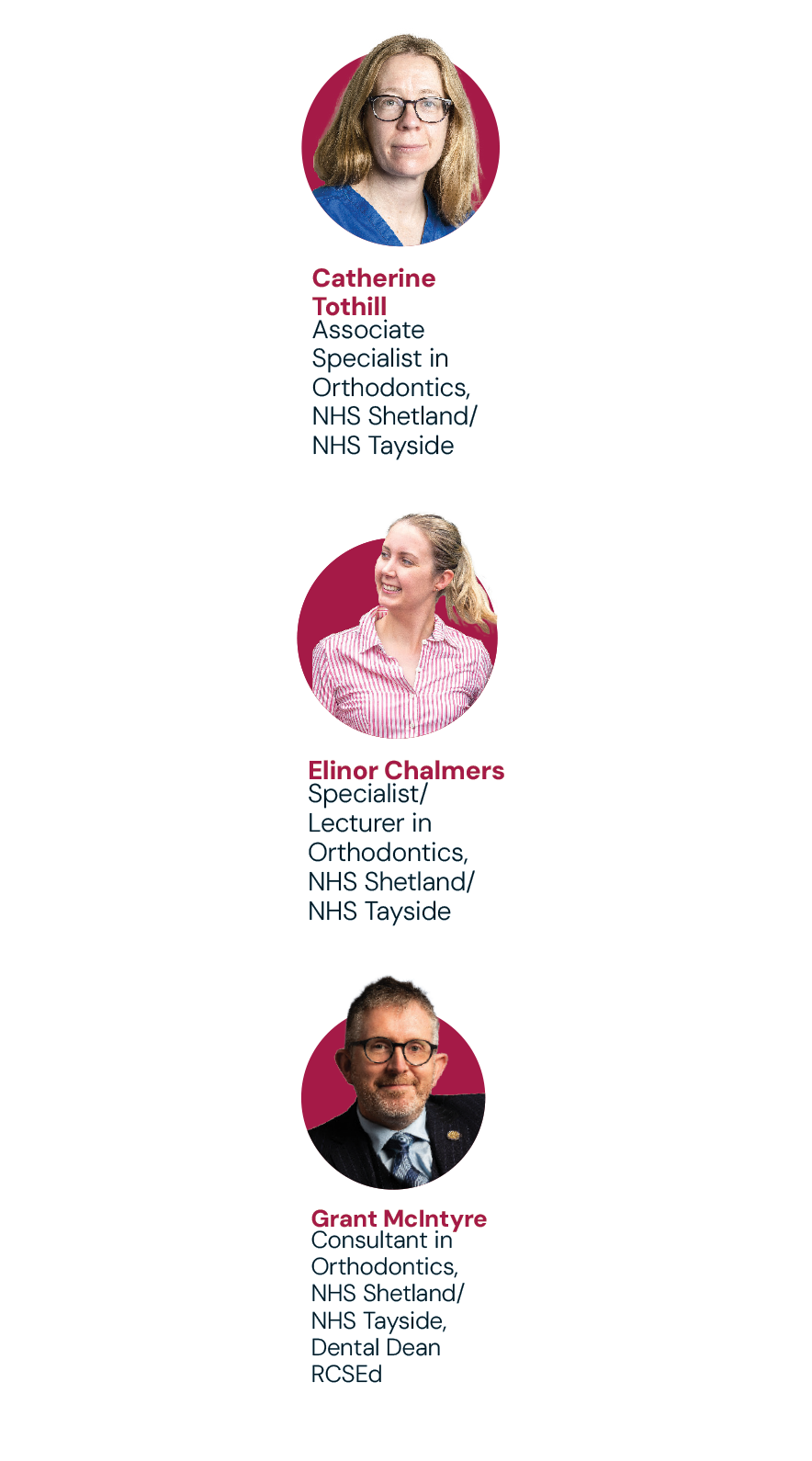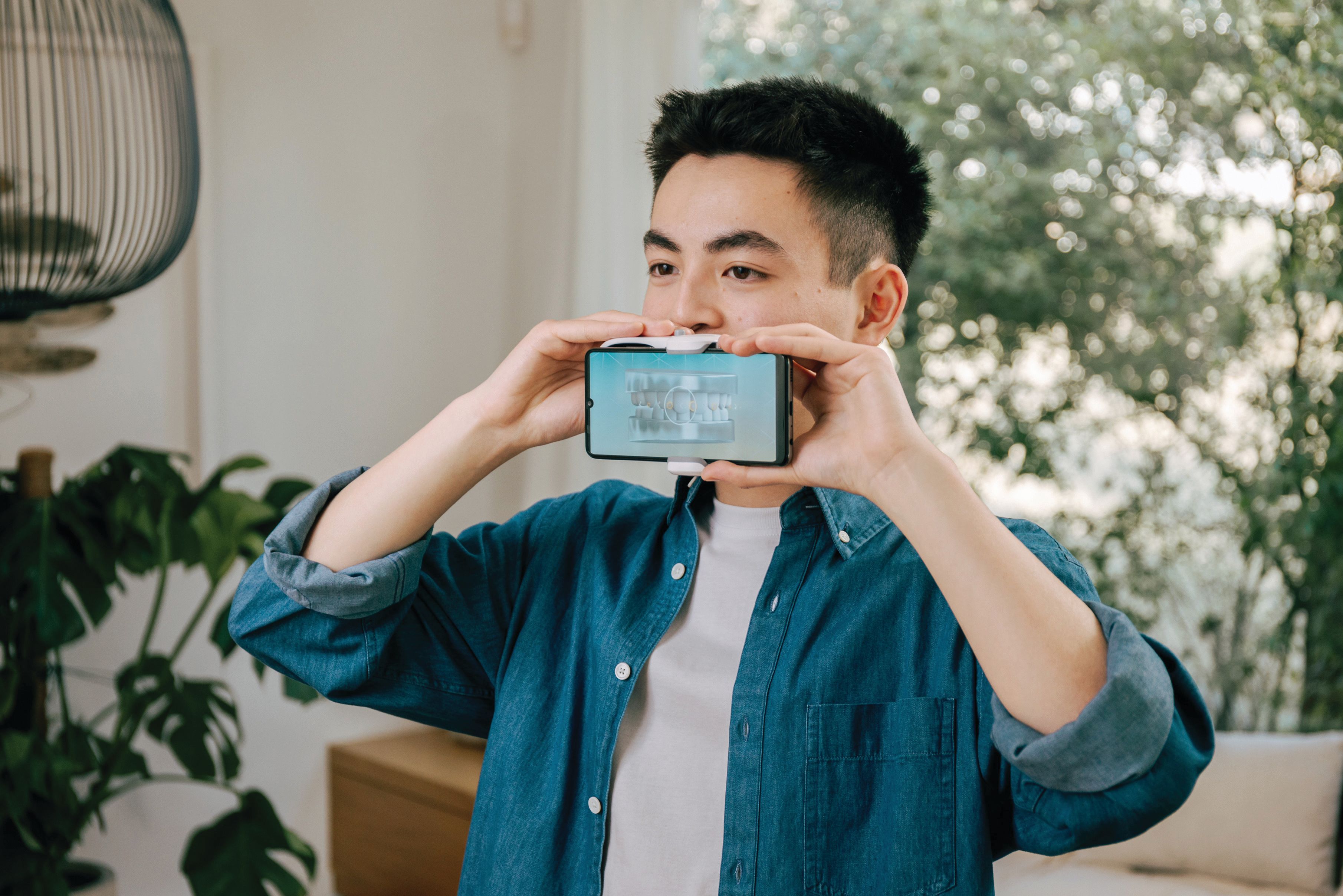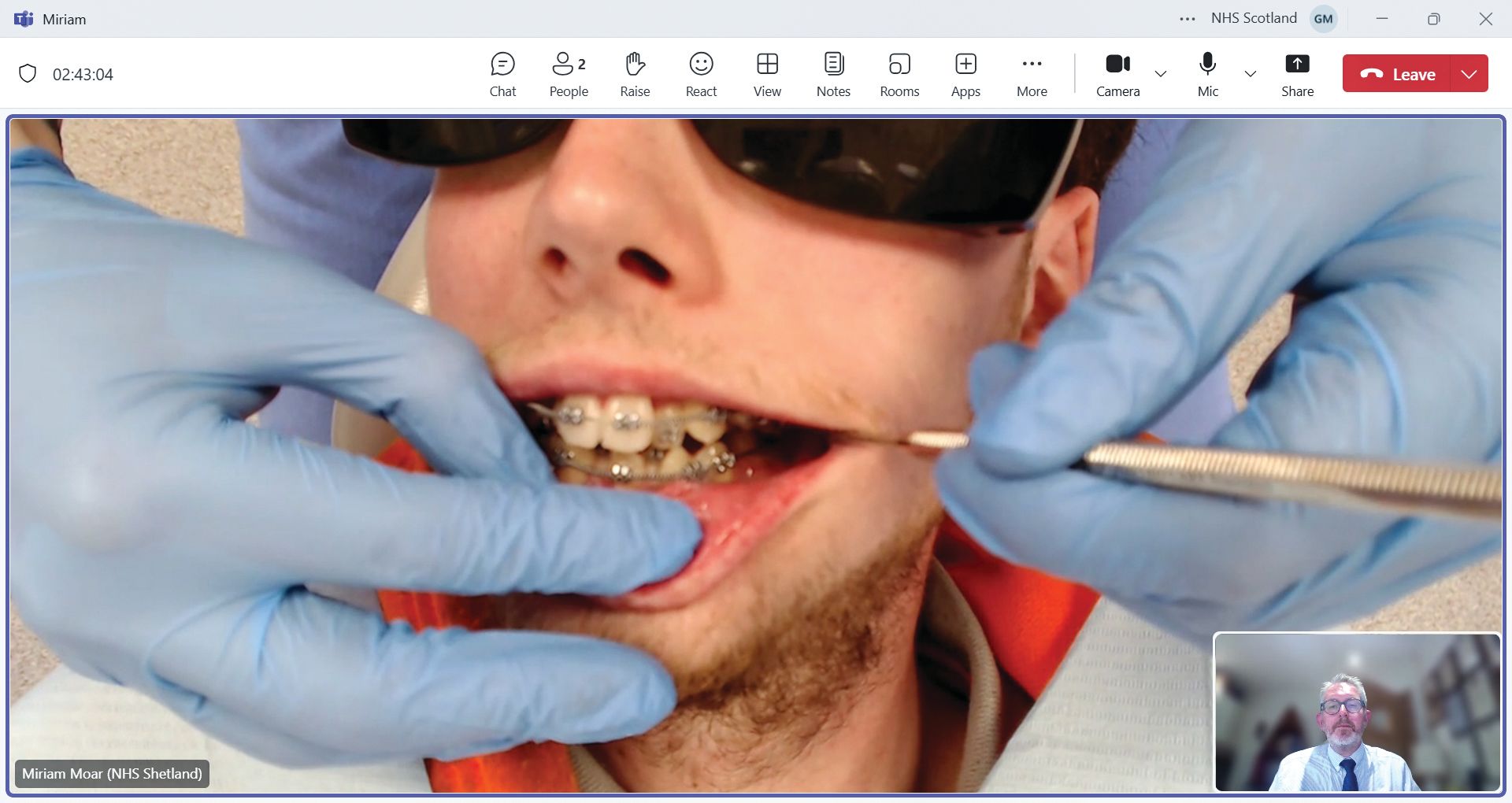Technology, training and travel for remote-control orthodontics in Shetland
Exploring the unique challenges of dental care in one of the most remote island communities in the UK

In May 2024, NHS Shetland embarked on a new initiative for a Scottish island Health Board. Until then, the orthodontic service relied on ‘fly-in and fly-out’ specialist service delivery. The new model involves the training and employment of on-island Orthodontic Therapist expertise supported by a combination of in-person and remote specialist support along with the deployment of technology to assist with remote training, patient care and service delivery. This is already both addressing the workforce challenge and providing a sustainable dental service delivery for the remotest island community in the UK.
Training
Shetland, like many remote, rural and island communities, faces a unique set of healthcare challenges, including the recruitment and retention of dental professionals, training and workforce development and long-term support. Being 300 miles north of Edinburgh, the geographical isolation and limited access to specialist training opportunities have historically hindered the upskilling of the on-island dental workforce. Recognising these challenges, NHS Shetland sought to create a training programme in conjunction with NHS Education for Scotland (NES) and a long-term support structure that would allow the Orthodontic Therapists to be trained and supported without the need to relocate to the mainland and leave their family and community. Sustainable developments are, after all, only sustainable if they can be sustained. Two trainee Orthodontic Therapists were, therefore, appointed by NHS Shetland and selected for the NES Orthodontic Therapy Training Programme for 2024-25.
The NES Orthodontic Therapy Training Programme is a UK General Dental Council (GDC)-approved course leading to a Diploma in Orthodontic Therapy, awarded by the Faculty of Dental Surgery at the Royal College of Surgeons of Edinburgh. The programme is traditionally delivered throughout the calendar year, with combined intensive teaching blocks and a clinical placement supervised by a GDC-registered orthodontic specialist.
NHS Shetland and NES collaborated to accommodate the unique circumstances in Shetland by adapting the existing training model. The course duration was extended to two years with part-time clinical work, allowing the required clinical supervision hours to ‘tot up’ locally. This predominately ‘on island’ training model has ensured that the trainees have remained in their community, maintaining continuity of care for local patients while developing their specialty skills.
Patients can use AI tool Dental Monitoring to take intraoral images
Patients can use AI tool Dental Monitoring to take intraoral images
Technology
Remote supervision of the trainee Orthodontic Therapists and remote patient consultations for new and review appointments has been made possible with the aid of various technologies, including:
Remote appointments
All new and many review patients are assessed using the NearMe system, while all long-term post-treatment follow-up is provided through Dental Nurse telephone clinics.
Digital electronic patient record
For remote appointments and when supervising the trainee Orthodontic Therapists, the supervising orthodontist has remote access to a dental EPR, which allows the clinician to view the appointment diary and each patient’s notes. This includes medical history, letters to other clinicians and full records of the patient’s orthodontic treatment journey. Radiographs can be viewed using the Scottish national PACS software (Picture Archiving and Communication System). Dental study models are scanned to provide 3D digital models. These can be viewed remotely by the supervising clinician to aid with treatment planning.
Microsoft Teams
When supervising the trainee Orthodontic Therapists, case discussions are held at each patient appointment over Microsoft Teams. The trainee provides a brief summary of the patient’s original problems and treatment to date. The plans for the treatment at each appointment are then discussed. The supervising Orthodontist is able to explain the next stages of treatment to the patient and the patient can ask any questions (if required).
Dental light camera
The trainee Orthodontic Therapist has a camera attached to the dental light. Using the Microsoft Teams platform, this provides the supervising clinician a bird’s eye view of the patient’s teeth. This offers a quick overview of current stage of treatment and helps with planning for the next stage.
Dental Monitoring
DM is an AI-powered platform that was designed for remote monitoring of orthodontic treatment. Each patient has a Scan Box Pro device that they use along with their smartphone to take intraoral images once a week. These are sent to the DM platform, which uses AI to analyse, crop and sort the images. The AI can detect problems such as poor oral hygiene and a broken brace and can message the patient through the app to let them know.
This is an extremely useful tool that enables the trainee Orthodontic Therapist and the supervising specialist Orthodontist to visualise the patient’s occlusion. This is
helpful for the clinician to be able to prescribe the next stage of treatment. It also provides excellent learning for the trainees, who are able to see treatment changes during longitudinal care.
Trainer trainee ratios are 1:2 at weekends and 1:6 on weekdays, with the latter involving the trainees being supervised along with the range of orthodontic specialty trainees in Dundee Dental Hospital and Research School. The trainees, therefore, have a near-identical training experience to other dental trainees, while the mix of in-person and online supervision has provided an innovative model for the development of entrustable professional activities. The team was determined to ensure not only that clinical supervision was a priority, but that non-clinical support was also a key focus, along with the provision of specialist clinical input for complex cases and challenging clinical encounters. Ultimately, these concepts have been key to ensure the quality of training is no different to a traditional in-person system, and to promote the highest levels of overall patient safety along with a positive patient and team experience.
The training of the Orthodontic Therapists started in May 2024 with an intensive month in Edinburgh, providing foundational knowledge and skills. Following this, clinical sessions have been scheduled in Shetland over the subsequent 24 months. Appropriate patients are selected for the trainee Orthodontic Therapists based on complexity of care and each visit is planned in advance. Where the patient encounter or task requires a clinician to be physically present, these are reserved for on-island visits by one of the specialist team. The backstop position for any unplanned complex clinical situation is that a Public Dental Service dentist is available on the premises for all remotely supervised clinics and patients are counselled at the outset of treatment that there may be a rare situation where the appointment is beyond the level of training or scope of practice for the trainee Orthodontic Therapist and the appointment may need to be rescheduled.
The NES Trainee Orthodontic Therapist curriculum encompasses a range of competencies, including the placement of orthodontic appliances, adjustment of archwires and patient management, all under the prescription and supervision of a qualified specialist orthodontist. This hands-on training is complemented by theoretical education, ensuring a comprehensive understanding of orthodontic principles and practices.
A dental light camera enables the supervising clinician to view a patient’s teeth remotely
A dental light camera enables the supervising clinician to view a patient’s teeth remotely
Travel
All healthcare services produce greenhouse gas emissions, with dentistry and orthodontics being no exception, which contribute to the global environmental crisis that threatens human health. Globally, the healthcare sector has been shown to contribute 1-5% of emissions. NHS Shetland, as a Scottish health board, has committed to reaching net zero by 2040 as per the NHS Scotland climate emergency and sustainability strategy: 2022–2026.
Staff and patient travel to appointments has been shown to be the highest contributor to the carbon footprint (CF) of dental services1. The ‘fly-in and fly-out’ specialist service delivery model is an extreme example of staff commutes, with short-haul flights having a large CF because the relationship between flight time emissions is not linear, with the fuel consumption for take off and landing being disproportionate2. Clinicians can opt to travel to Shetland by overnight ferry but this also contributes to greenhouse gas emissions, with maritime transport being responsible for 3.3% of emissions globally (and increasing)3. When the Orthodontists arrive at Sumburgh airport they then drive 45 miles to the clinic in a petrol hire car, which is a well-known carbon contributor.
Patients in Shetland use a wide variety of travel methods because of the local geography, including car, bus, ferry and aeroplane. A recent patient travel survey of 30 patients found 537 miles were travelled by internal combustion engine cars and 22 miles by bus. Two patients travelled by ferry from the island of Yell and one had to fly from the island of Foula.
The establishment of the trainee Orthodontic Therapists has reduced the reliance on orthodontic clinicians having to be ‘in person’ for every treatment appointment for the patients in Shetland. As well as increasing the capacity of the number of patients in treatment this has significantly reduced the CF for staff travel.
Along with monitoring patient treatment remotely, the introduction of DM also has the potential to reduce patient travel to appointments as this has been shown in patients undergoing aligner treatment4.
Summary
The successful integration of this training programme has yielded sustainable benefits for NHS Shetland and could provide dividends for the broader island communities where the model is adopted in the future. By upskilling existing staff and integrating technology into the service, overall service delivery has been enhanced, waiting times reduced and, crucially, patient outcomes and patient safety protected. Furthermore, the programme serves as a model for other rural and remote areas facing similar challenges.
By demonstrating the feasibility and effectiveness of localised training solutions, NHS Shetland provides a replicable framework for enhancing healthcare delivery in remote and island communities in the UK and internationally.
For more information on the NES Orthodontic Therapy Training Programme, visit NES Turas at https://turasdashboard.nes.nhs.scot/
References
1. Duane B, Hyland J, Rowan JS, et al. Taking a bite out of Scotland’s dental carbon emissions in the transition to a low carbon future.
Public Health Nutr 2012; 126(9): 770–7.
2. Livingston KS, Jackert EP, Diab M. The carbon footprint of American Academy of Orthopaedic Surgeons and Pediatric Orthopaedic Society of North America national meetings. J Pediatr Orthop. 2024; 6: 100011.
3. Chou CC, Hsu HP, Wang CN, et al. Analysis of energy efficiencies of in-port ferries and island passenger-ships and improvement policies to reduce CO2 emissions. Mar Pollut Bull 2021; 172: 112826.
4. Hansa I, Katyal V, Ferguson DJ, et al. Outcomes of clear aligner treatment with and without Dental Monitoring: a retrospective cohort study. Am J Orthod Dentofacial Orthop 2021; 159(4): 453–9.
Further reading
1. Duane B, Steinbach I, Mackenzie L. A carbon calculator: the development of a user-friendly greenhouse gas measuring tool for general dental practice (Part 2). Br Dent J 2024; 236(1): 57–61.
2. Lenzen M, Malik A, Li M, et al. The environmental footprint of health care: a global assessment. Lancet Planet Health 2020; 4(7): e271–9.
3. Martin N, Hunter A, Constantine Z, et al. The environmental consequences of oral healthcare provision by the dental team. J Dent 2024; 142: 104842.
Read more




